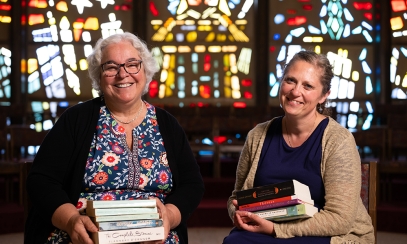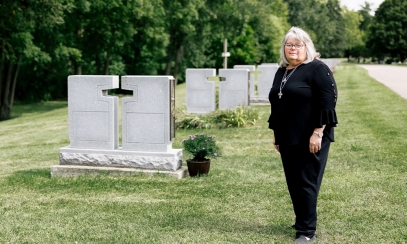
A life of hidden purpose
Getting your Trinity Audio player ready...Ann-Arbor based author, Kevin Perrotta, pictured, has just written a biography of Blessed Miriam Teresa Demjanovich, an early 20th century Sister of Charity nun from New Jersey. Why? FAITH Magazine has been finding out.
Ann-Arbor based author, Kevin Perrotta, pictured, has just written a biography of Blessed Miriam Teresa Demjanovich, an early 20th century Sister of Charity nun from New Jersey. Why? FAITH Magazine has been finding out.
Perrotta says that, while growing up in New Jersey, “My family belonged to St. Mary’s Parish, where Father Charles Demjanovich was pastor. Once in a while, someone would say, ‘Father Charles’ sister is going to be a saint!’ But I didn’t take much interest then,” he recalled.
Perrotta learned about Miriam Teresa (1901-1927) after her beatification in 2014 and is preparing a biography. She was a member of the Ruthenian Greek Catholic Church, which is in communion with Rome. In college, she wanted to join the contemplative Carmelites of the Latin rite. This was just one unexpected turn in a quiet, pious life, with an unappreciated mystical affiliation with Jesus Christ, ending with her death when she was 26. Ann Arbor resident, Perrotta, spent weeks researching documents about her. “People make generalizations: ‘she was a devout girl,’ ‘she was a normal girl,’ ‘she was a good student.’ But that’s not a biography,” he said. Miriam Teresa was not an outsized figure, but lived an ordinary life as a devoted daughter and obedient novice. Perrotta says, “To understand someone like her, who was radically into religious life, presents challenges to those outside for understanding: Where is the message for me? How do I access it?”
“The great drama in Demjanovich’s life is the discovery of her vocation … Her recognition of her vocation can help us understand discipleship in lay life,” Perrotta said.
Very reserved, she was hard to understand. She opened up only to her spiritual director, Father Benedict Bradley. “No one else penetrated her thinking,” Perrotta said.
She once wrote: ‘The end of the beginning was on Dec. 8th, 1924,” the feast of the Immaculate Conception. God wanted her to join the active Sisters of Charity and tell them that active life is fully compatible with and needs to be grounded in contemplation. “You can’t be just Martha in religious life but also Mary,” Perrotta observed in a reference to the Gospel of Luke 10:38-42.
“That was the point where she knew from God what he wanted her to do and the point of connection for any Catholic reader. The way she discovered her vocation and how God revealed to her were unusual.” While her quiet nature seemed designed for the contemplative Carmelites, she was not admitted.
“When I was little, the Lord told me the meaning of life,” Miriam Teresa told Father Bradley: “It’s to do his will.” He said she experienced a full range of spiritual phenomena, including divine locutions since childhood, and never deliberately sinned.
As a novice, Miriam Teresa taught in a school but disliked teaching. Impressed by her authentic spirituality, Father Bradley asked her to write reflections he delivered to novices, but asked her not to reveal authorship to Novice-Mistress Mary Ellen, who believed she was more suited to the Carmelites. In December 1926, She was hospitalized for exhaustion and returned in January 1927. Doctors could not diagnose the condition, as her health failed during months in hospital. And it was only on her deathbed that she was finally admitted to the Sisters. Kept in the dark at the time about Miriam Teresa’s spirituality, Sister Mary Ellen later acknowledged God had withheld understanding “for her sanctification and my humiliation.”
In her reflections, titled Greater Perfection, Miriam Teresa praises a spousal bond with Jesus, distilling Psalms and Scriptures: “There is no life of activity so distracting but what the Divine Spirit can convert into the only true hermitage — a life Hidden with Christ in God … In a special sense, we are those very disciples whom Christ wills to be in the world, but not of it. For what did He pray? “That thou shouldst keep them from evil. (Jn 17:18)”
For years, she struggled to understand God’s call. But it became clear that God wanted her to mine the riches he gave her to help the Sisters of Charity see that a deeper relationship with God is needed in order to be the active order that they were.
While joining a religious order to reform it might seem arrogant, she was utterly convinced of her mission from God. “It was with absolute clarity and joy,” Perrotta said of Miriam Teresa’s conviction: “It’s very thought-provoking.”
Perrotta is the author of a series on the Bible and co-author, with wife Louise, of Oneness, a book on the marriage vocation.
“In my own life, as a husband, in a different way than Miriam Teresa, I did come to the point where I knew God’s purposes for me; not that he’s telling me to marry Louise, but it’s what I really wanted AND I sensed that it was God’s purpose. Reflecting on our marriage and Miriam Teresa, it’s clear that human life is a matter of God’s calling. He creates us for a purpose: to discover and live it out just as clearly as Miriam Teresa heard from God what he wanted her to do.”
Martin Barillas and his wife attend both St Thomas the Apostle in Ann Arbor and St Stephen Byzantine Catholic parish in Allen Park.



